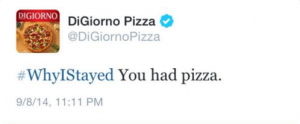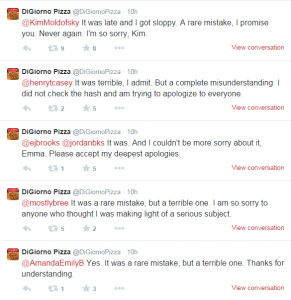The Language of Social Media: The Power of The Hashtag
Chris Messina, a former Google designer, was the first to propose to Twitter, the adoption of the hashtag (#). The picture below, dating back to August 2007, is the first ever tweet using the hashtag symbol in its present day use (Page, 2012).
Today, hashtags are used in almost all other social media platforms, such as Facebook, Instagram, Pinterest, and LinkedIn. Hashtags are widely used to define a shared context for specific events, topics, or meme (Ma et al, 2012). On most social media websites, a hashtag is translated into a clickable link that enables an easy search of tweets using the same hashtag (Suh et al, 2010). On Twitter, a frequently used hashtag amongst a large portion of its’ users could appear on the ‘trending topics’ sidebar on their website, which promotes a topic or term to an audience which extends far beyond the follower list of the person who used the hashtag. Landing on the ‘trending topics’ list is perceived as having influence or holding a status (Page, 2012).
Beyond being a bookmark for content, the hashtag serves as the symbol of a community (Yang et al, 2012). This virtual community is defined through the hashtag of users with the same background, the same interest, or involved in the same conversation or task.
symbol of a community (Yang et al, 2012). This virtual community is defined through the hashtag of users with the same background, the same interest, or involved in the same conversation or task.
A user can join such a community by sampling including the hashtag in their own tweets (Yang et al, 2012).
According to Forbes, tweets with hashtags get two times more clicks, retweets, favourites, and replies than tweets without hashtags (Patel, 2015). However, there is a limit to the usage of hashtags on a single post on different social media channels. Forbes recommends that for Twitter, the maximum amount of hashtags to use in one single tweet is two. Any more than that, and a company can diminish their engagement. In contrary, the limit on Instagram is endless. A post harnessing eleven or more hashtags retains the highest engagement.
Sure, having hashtags on posts help. But how do companies utilise the hashtag to its fullest potential?
- Invent your own unique hashtag that describes the company or product. For example: ‘ToBeSharedAgain’
- Start a hashtag movement – Popular hashtags have the ability to launch revolutions. For example: #blacklivesmatter
- Participate in trending hashtags and customise your own Twitter trends by viewing the ‘trending topics’ tab on Twitter’s website (Patel, 2015)
Success story of the hashtag: #MakeItHappy campaign
Coca Cola evoked emotion through their Superbowl ad during last year’s TV event. The ad showed coca cola spilling into the wiring of the Internet, causing every negative message online to turn into a positive one, followed by the hashtag #MakeItHappy appearing on the screen. The message of the ad correlated directly with the company’s values of Happiness – and was only perpetuated by evoking emotion and further engaging consumers on social media. This engagement was powered by the clever algorithm that the company created, converting every tweet with the #MakeItHappy tag into pictures of cute dogs or the like. People quickly jumped to share their messages of positivity and fun, all through the Coca Cola name. (Yohn, 2015)
Now, to contrast: #WhyIStayed Campaign:
DiGiorno Pizza’s #WhyIStayed campaign is a clear example of how using a hashtag on social media can quickly turn ugly. Trying to participate in trending tweets to gain brand recognition, DiGiorno tweeted the below:
 Unfortunately, the company posted this without looking into the context of the hashtag. Women from all over the world were tweeting stories about their domestic abuse stories, using the exact same tag: #WhyIStayed. Although DiGiorno quickly responded by deleting the tweet and replying to upset Twitter users, it goes to show that one innocent hashtag mistake could lead to an uproar of negative press for a company (Griner, 2014).
Unfortunately, the company posted this without looking into the context of the hashtag. Women from all over the world were tweeting stories about their domestic abuse stories, using the exact same tag: #WhyIStayed. Although DiGiorno quickly responded by deleting the tweet and replying to upset Twitter users, it goes to show that one innocent hashtag mistake could lead to an uproar of negative press for a company (Griner, 2014).
How can companies measure the hashtag’s success?
- Use analytics websites such as; Hootsuite, Sproutsocial, Hashtracking (Geho et al, 2012)
- If the company is using their own hashtag such as: #ToBeSharedAgain, they can search this tag on instagram and it will show how many times the tag has been used: for example:
Lessons learned:
- Hashtag can be meaningless if it doesn’t affect company positively
- Hashtags should be used less as a message and more as a call to action for consumers that leads to greater brand engagement
- However, these hashtags can only directly lead to greater brand engagement if they are used as the starting point for participants
- Think before you Tweet!
Sources:
Coca Cola, (2013). Coca-Cola Make It Happy Coca Cola Big Game Commercial 2015 #MakeItHappy Vote: 6.50 USA Today. Available at: https://www.youtube.com/watch?v=XwRwuQmS45U [Accessed 3 Apr. 2016].
Geho, P. and Dangelo, J. (2012). THE EVOLUTION OF SOCIAL MEDIA AS A MARKETING TOOL FOR ENTREPRENEURS. 17, pp.69-74.
Griner, D. (2014). DiGiorno Is Really, Really Sorry About Its Tweet Accidentally Making Light of Domestic Violence. [online] AdWeek. Available at: http://www.adweek.com/adfreak/digiorno-really-really-sorry-about-its-tweet-accidentally-making-light-domestic-violence-159998 [Accessed 6 Apr. 2016].
Ma, Z., Su, A. and Cong, G. (2012). Will This #Hashtag Be Popular Tomorrow?. School of Computer Engineering.
Page, R. (2012). The linguistics of self-branding and micro-celebrity in Twitter: The role of hashtags. Discourse & Communication, 6(2), pp.181-201.
Patel, N. (2012). How To Harness The Power Of The Hashtag As An Entrepreneur. [online] Forbes.com. Available at: http://www.forbes.com/sites/neilpatel/2015/08/17/how-to-harness-the-power-hashtag-as-an-entrepreneur/#14747e3c45fa [Accessed 2 Apr. 2016].
Suh, B., Hong, L., Pirolli, P. and Chi, E. (2010). Want to be Retweeted? Large Scale Analytics on Factors Impacting Retweet in Twitter Network. Palo Alto Research Center, Inc.
Walaski, P. (2013). Social Media Powerful Tools for SH&E Professionals. [online] Program Development Peer-Reviewed. Available at: http://www.asse.org/assets/1/7/040_049_F1Wala_0413Z.pdf [Accessed 1 Apr. 2016].
Yang, L., Sun, T., Zhang, M. and Mei, Q. (2012). We Know What @You #Tag: Does the Dual Role Affect Hashtag Adoption?. School of Information, the University of Michigan.
Yohn, D. (2015). Use Hashtags to Generate Greater Brand Engagement. [online] Forbes.com. Available at: http://www.forbes.com/sites/deniselyohn/2015/02/18/use-hashtags-to-generate-greater-brand-engagement/#5c44e4e62d76 [Accessed 1 Apr. 2016].


